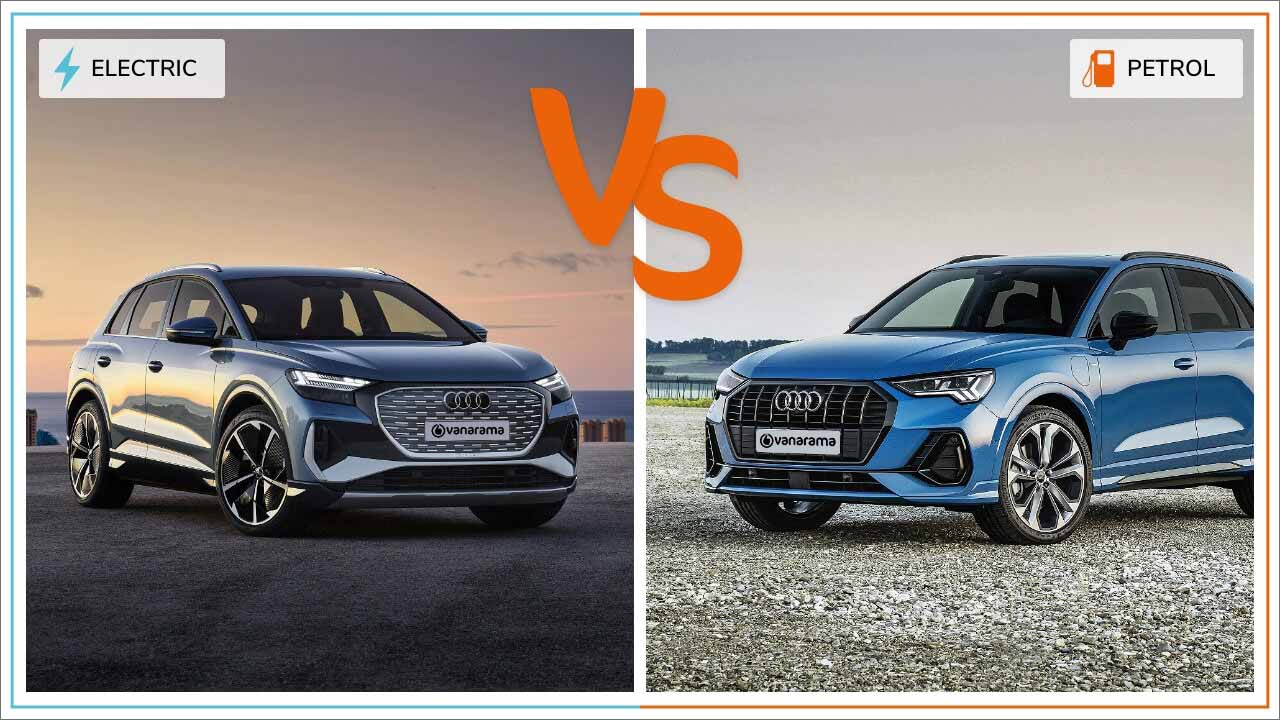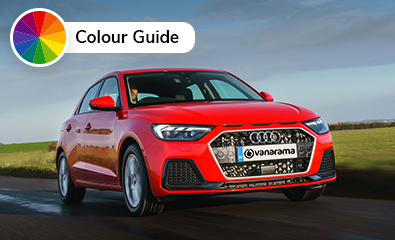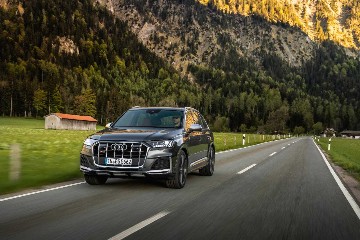Audi may not have the premium small SUV sector largely to itself anymore, but it remains one of the dominant players with the Q3 and Q4. Both are available as classic ‘SUV estates’ or slightly less practical Sportback models, so there’s plenty of choice while keeping those four rings on the snout. The debate between petrol and electric is not so clear-cut as the EV is cheaper to run but pricier to lease.
Audi was among the first to offer a posh compact SUV with its first Q3, but it’s a very different landscape now. There are rivals such as the BMW X1 and BMW X2, Mercedes GLA, Range Rover Evoque, and Volvo XC40, among more. Then there’s competition from within its own ranks with the all-electric Q4 E-Tron, plus Sportback versions of the Q3 and Q4 with their more steeply sloping tailgates.
The Q3 is offered with the expected petrol and diesel engines, as well as a petrol-electric hybrid powertrain option. For the Q4, Audi has switched to its E-Tron all-electric drivetrain and, like most cars in its overall range, there is a decision to be made between 2- and 4-wheel drive. However, that’s a decision related to solely drivetrains – the top-spec Q4 50 is a quattro 4WD, with the less-powerful Q4s sticking to 2-wheel drive. Even then, things are a little different as these have a rear-drive set-up, rather than Audi’s usual preference for front-wheel drive. This is because the Q4 is based on the same platform as the Volkswagen ID.4 and Skoda Enyaq.
There is common ground when it comes to the cost of leasing a Q3 or Q4, but when comparing cars with the same trim and specification, the fossil-fuel-powered Q3 is notably cheaper. Will that influence your decision? We’ll see.
Design Differences
There’s a clear commonality of design cues with the Q3 and Q4 as they both come from the same styling department. However, it’s clear the Q3 is the more conservative in its looks, with Audi determined not to alienate a strong customer base built up over more than a decade. The Q4, on the other mitt, stems from a bolder pen. It has a more aggressive look with its huge (even by Audi standards) grille that seems to be squeezing the headlights out of the frame. This grille is purely decorative, as all of the cooling air for the batteries is drawn in through the vents below.
Along the sides and at the rear, the Q4 is again more style-led, though this is not necessarily for the best as the Q3 enjoys a simplicity of line that feels a lot less ‘look at me’. The same is true inside, with the Q3 taking a more muted approach to how it integrates the Volkswagen Group twin-screen dash into its cabin. For the Q4, Audi has turned the dial up to 10.5, with the raised centre console and angular steering wheel that feels oddly lumpy as it feeds through your hands when you steer. We just wish Audi had swung that design dial all the way to 11 because the Q4’s interior is frustratingly sensible in most ways and irksomely daft in others.
Pop on our X-ray specs, and we see the real differences between Q3 and Q4 lie in the techy bits. The Q3 has its engine in the expected transverse layout to drive either the front wheels or all 4, depending on which model you choose. For this comparison, we’ve gone for the all-wheel drive quattro version with a 190hp 2.0-litre turbo petrol engine and 7-speed automatic gearbox.
Turn our sights to the Q4 and it’s the first mass-produced rear-wheel-drive Audi produced, with the R8 supercar its only real predecessor. This is a big move for Audi given its long-standing sniffiness on the topic of rear-drive, but it’s one that has been forced on it by the use of the same platform which underpins the Skoda Enyaq and VW ID.4 for cost reasons. You can order the Q4 with all-wheel drive, but you’ll need to spend the extra on the 50 model as neither the less powerful 35 nor 40 versions are offered with it.
Driving Differences
We’ll begin with the Q4 here. On a typical British A-road, this EV is one of the best of its breed for controlling the tug of war between body and wheels over bumps. It’s up there with the cushiness of the Skoda Enyaq and betters the Jaguar I-Pace by some margin. If you want the very best of comfort in the Q4, you need to add the adaptive suspension that lets you tailor its reactions to the road ahead. However, even on the standard set-up, it’s very good and the Q4 is massively more refined than a Ford Mustang Mach-E in the way it deflects noise away from the cabin. We’re also admirers of the impressively tight turning circle of the 2-wheel-drive models of Q4 and it handles in a typically Audi fashion, with reassuring amounts of grip without ever bothering to engage much with the driver.
As for performance, the Q4 goes from decent to ‘cor blimey’ acceleration, based on which model you choose. The 35 is adequate for most needs, while the 50 is hot-hatch quick. We’d settle in the middle with the 40, that provides enough urge for all occasions without draining its battery too swiftly.
Now for the Q3. Despite having an internal combustion engine and all the fiery explosions that entails, the petrol-powered Q3 in this comparison does not fall far short of the refinement of its Q4 sister. There’s a touch more growl from under the bonnet at all speeds, but road noise is ably suppressed at higher speeds and wind rustle is not an issue.
Normally, we’d err more towards the 1.5-litre 3-cylinder petrol engine as our preferred motor for the Q3, but in the interests of a fair comparison the 190hp 2.0-litre 4-cylinder turbo is chosen here. It provides rapid pace on a par with the Q4 50, while its 7-speed twin-clutch auto is smooth to the point where it doesn’t register with you that it’s changing gear.
How the Q3 copes with battered roads is down to which model you pick. Go for the top-level Vorsprung and you get the adaptive suspension that works so well on the Q4, and it’s the same story with the Q3. Choose the S line or Edition 1 variants and you get Audi’s stiffened suspension that it clearly regards as sch-porty. However, it’s a Nein danke from us as it’s just too jiggly and unsettled most of the time, with a knock-on effect to refinement. Far better is the standard suspension of the Sport model we have here. It does a perfectly acceptable job for this type of car, balancing comfort with body control in much the same way as a Volvo XC40 or Hyundai Tucson.
Practicality Differences
More than anywhere else, the difference between the Q3 and Q4 is most easily spotted from the driver’s seat. In the Q3, you sit in a mildly elevated position compared to any hatchback surrounding you, but in the Q4 you sit up and look over most other cars. Admittedly, you won’t be eyeball-to-eyeball with van drivers, but the Q4 imparts that feeling of SUV freedom of vision much more, and it also has the better all-round vision for parking.
Both Q3 and Q4 have Audi’s configurable digital dash. Is it handy? Maybe, but we’ve found we settle on a screen we like and stick with that, unless using the satnav. As for the central infotainment display, both cars have a 10.1-inch screen that is clear and logical. Oddly, Audi’s take on this is easier and better to use than that found in the Volkswagen ID.4 or Skoda Enyaq, which is unusual given they are all from the same overall car company. We also like that Audi provides physical buttons for the heating controls in each of its cars to make adjusting temperature simpler on the move.
Jump in the back seats and the larger Q4 is the better for taller passengers and offers more room in every direction for adults. In the Q3, your kids will be more than happy, but your mates will only want to be in there for up to an hour tops. Put the same chums in the back of the Q4 and they’ll be happy in it all day long.
The trade-off here is the Q4 has a little less luggage capacity than the Q3, not helped by the rear-mounted electric motor snaffling a little space. Pack every available space in the Q3 and it has 530 litres of space with the seats up and 1525 litres with the back pews folded down. The Q4 manages 520 and 1490 litres in the same configurations, respectively.
Running Cost Comparison
In a buck to the usual trend, the Q4 E-Tron sits in a lower insurance group than the petrol Q3. Go for the EV and its premium is based on a group 29 rating, whereas our chosen Q3 is in group 30. The Q3’s financial burden continues with its Vehicle Excise Duty of £555 versus zero for the Q4, and the Q3 will cost a low-rate tax paying company driver £2666 per year while the Q4 is a mere £84 across the same period.
Audi claims the Q4 E-Tron 40 can travel 317 miles on a full charge. With a brimmed tank, the Q3 40 TFSI quattro can manage a maximum of 490 miles before it sips its last drop. With the petrol car, you’ll need a service stop every 9000 miles or 12 months, while the EV goes for twice the distance and duration before it needs a dealer visit. Both cars are protected by Audi’s 3-year and 60,000-mile cover, and the Q4 has an additional 8-year, 100,000-mile battery warranty.
Living With the Electric Car
Unlike the entry-point Q4 E-Tron 35, the 40 model we’ve opted for here can use chargers of up to 125kW, so you could re-energise the battery in as little as 35 minutes from 10- to 100% charge. Audi provides a Mode 3 cable for use with Type 2 public chargers and you also get a cable to hook the car up to a domestic 3-pin socket in case of emergencies, though this will take a long time.
The MyAudi app lets you do all of the usual smartphone stuff with the Q4, such as remotely check battery charge, charging times, and remaining range. It also lets you locate the car in crowded car parks, download destinations to the satnav, and even checks screen washer fluid level. Perhaps a more useful feature on a daily basis is the app will find available charging points and can precondition the cabin to your desired temperature while still attached to a charger to prolong driving range.



